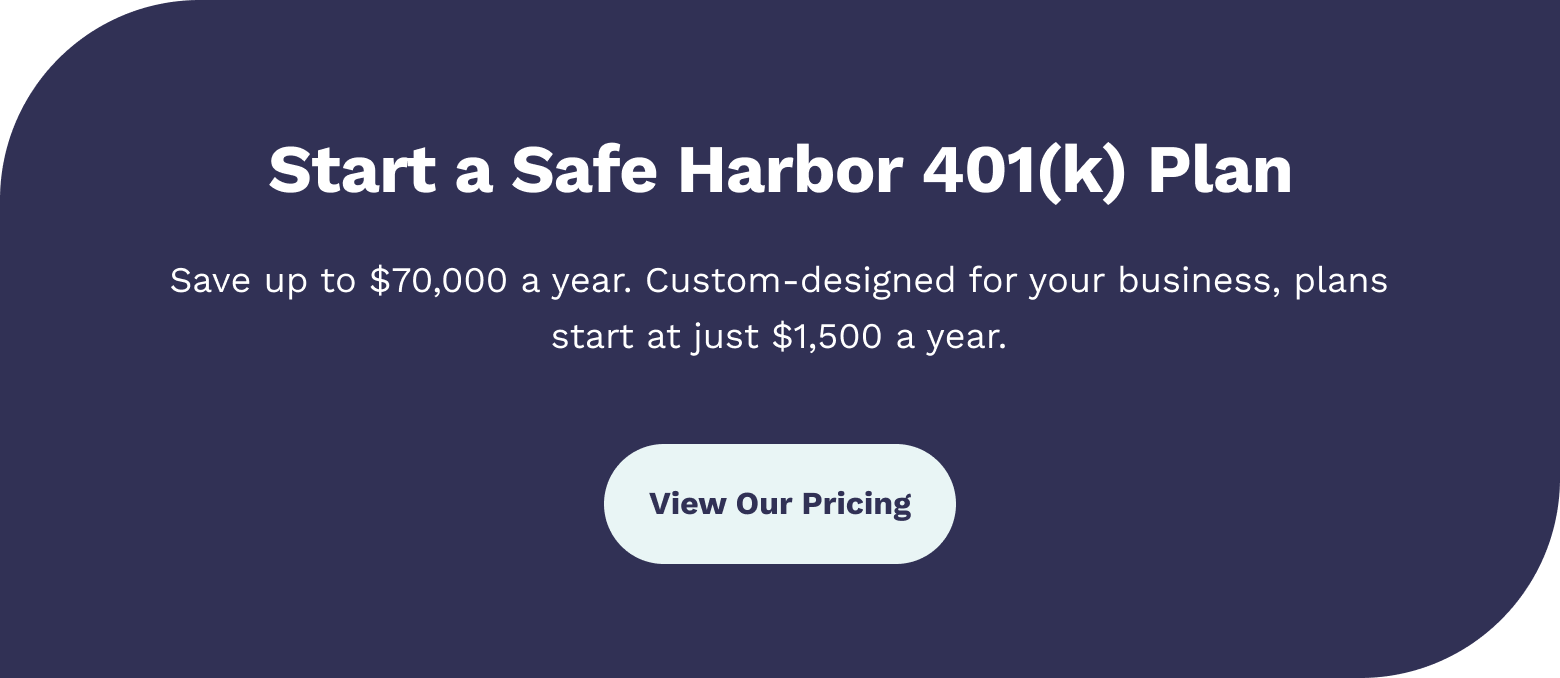SECURE 2.0 greatly expanded the Roth contribution options available to small business 401(k) plans, allowing employees more choices and significant new tax advantages. In a 2022 401(k) plan design study of 4,330 small businesses, we found 78% permit employees to treat elective deferrals as Roth contributions. We expect nearly all 401(k) plans to permit Roth contributions once the catch-up changes made by SECURE 2.0 take effect. We recommend employers and employees give Roth 401(k) contributions a fresh look given these changes.
This FAQ is intended to help employers and employees in deciding whether to offer or utilize Roth contributions. It summarizes the differences between pre-tax and Roth contributions, how to avoid taxation on Roth distributions, and who may be the best candidates for Roth contributions.
What are Roth 401(k) contributions?
Most 401(k) contributions are made on pre-tax basis. In other words, they are tax-deductible in the year they are made, and earnings are tax-free until distribution. Upon distribution, employees pay taxes on their pre-tax contributions and earnings at personal income tax rates.
In contrast, Roth contributions can offer employees a tax-free nest egg at retirement. However, to earn this benefit, employees pay taxes on their Roth contributions in the year they are made at personal income tax rates. Earnings may be distributed tax-free when part of a “qualified distribution.”
The pre-tax or Roth decision is not an all or nothing tax strategy. There are several different options for using a Roth account in a 401(k) plan. These options allow employees, including small business owners, to pick and choose when to use the pre-tax or Roth tax strategy.
Who can make Roth 401(k) contributions?
Unlike Roth IRA contributions, there are no income restrictions for Roth 401(k) contributions. Any employee can make them when allowed by their 401(k) plan. Starting in 2024, catch-up contributions for employees making over $145,000 (adjusted annually for inflation) must be Roth contributions.
What are the Roth rules for elective deferrals?
When employees decide to have money taken from their pay and contributed to the plan (elective deferrals), many of them can choose between pre-tax and Roth. It is up to the employer to decide whether to include Roth elective deferrals in its 401(k) plan.
Before SECURE 2.0, only elective deferrals, including catch-up contributions, could be treated as Roth contributions. Moving forward, higher earning employees will soon be required to treat catch-up contributions as Roth. In addition, employees may soon have the ability to have a Roth emergency savings account.
Annual limit
Roth elective deferrals are subject to the same IRS limit that applies to pre-tax elective deferrals. For 2025, the elective deferral limit is $23,500 (indexed for inflation). When applying this limit, any Roth and pre-tax deferrals are combined. Therefore, an employee wouldn’t be able to contribute $23,500 in pre-tax elective deferrals as well as $23,500 in Roth elective deferrals.
Catch-up limit
Employees over the age of 50 can make additional contributions above the IRS elective deferral limit to help them “catch-up” for not saving enough earlier. For 2025, the catch-up contribution limit is $7,500 (indexed for inflation). If Roth contributions are permitted in the 401(k) plan, an employee may choose to make catch-up contributions as either pre-tax or Roth elective deferrals.
Starting in 2024, catch-up contributions for employees making over $145,000 (indexed for inflation) must be made as Roth deferrals. If an employee making over that amount, including a small business owner, wants to make catch-up contributions after 2023, the 401(k) plan must already allow, or be amended to include Roth elective deferrals. This change may cause reluctant employers to add Roth contributions to their plans.
Emergency Savings Accounts
SECURE 2.0 created an emergency savings account (ESA) for non-highly compensated employees (NHCEs). When allowed by a 401(k) plan, an ESA can help employees accumulate a “rainy day” fund.
ESAs must be funded with Roth contributions. Therefore, an employer interested in providing an ESA must permit Roth contributions. If an employee exceeds the ESA account maximum of $2,500 (indexed for inflation), any further contributions would be considered Roth elective deferrals. If an employer decides to offer an emergency savings account (ESA), any distribution from the ESA is considered a qualified distribution regardless of age or contribution timing.
An employer should weigh the added operational tasks in deciding whether to help employees with an ESA. These tasks include monitoring account balances to prevent exceeding the limit, allowing at least one distribution per month, and ensuring the first four distributions per year cannot be subject to fees.
Whether the operational cost and burden are worth the potential benefit to the employees depends upon your business’s goals and circumstances.
What are the Roth rules for employer contributions?
SECURE 2.0 created the ability for employees to designate employer contributions, such as matching or nonelective contributions, as Roth contributions. If permitted by the employer, employees may only make the Roth designation if the employer contributions are 100% vested.
Although the law change is effective now, practically speaking, it will be a while before systems are in place with service providers and software companies to handle this designation. Moreover, IRS guidance is needed on certain administrative tasks, such as:
-
- Parameters for electing the Roth designation.
- IRS reporting of taxable income based on the Roth designation.
- Procedures for when the Roth designation occurs after the plan year and initial IRS reporting.
- Whether employers may set operational limits to the Roth designation(s).
We do not anticipate the necessary IRS guidance and system upgrades to be released before 2024.
What is an in-plan Roth 401(k) conversion?
An in-plan Roth conversion, also called an in-plan Roth rollover, is a reclassification of non-Roth accounts to Roth accounts.
If an employer elects to include a Roth elective deferral option, the employer can also permit these in-plan Roth conversions. An employee can convert any vested non-Roth account to a Roth account. This is possible even if an employee is not otherwise able to take a distribution from the plan (e.g., not yet age 59 ½, no termination of employment, etc.). For example, you have accumulated $65,000 in your match account over several years. If permitted under the plan, you can convert the $65,000 in match to a Roth account.
Employees may take advantage of in-plan Roth conversions in tax years where their income is low or their non-Roth account balance has dropped in value. In addition, employees, including the small business owner, can use in-plan Roth conversions to build a large tax-free account over time to hedge against their taxable investments.
When an employee makes an in-plan Roth conversion, the plan reports the converted amount as taxable income for the year of the conversion. The employee is responsible for paying the tax due on the converted amount. However, converted amounts are not subject to the 10% early withdrawal penalty or mandatory income tax withholding.
We recommend employees use caution in deciding whether to convert non-Roth accounts to Roth. They should fully understand the impact of the Roth conversion, including the income tax liability. Employees should work with a tax advisor before deciding to complete an in-plan Roth conversion.
How are Roth 401(k) contributions taxed at distribution?
Because Roth accounts are subject to income tax upon contribution or conversion, they are not taxable upon distribution. Earnings on the contribution or conversion are subject to income tax at distribution unless it is considered a qualified distribution.
Qualified Distribution
A qualified distribution is one that occurs at least five years after the year of the employee’s first Roth contribution or conversion and is made:
-
- On or after attainment of age 59½,
- On account of disability, or
- On or after the employee’s death.
If payment of a Roth account is not considered a qualified distribution, any earnings are taxable at personal income tax rates and may be subject to a 10% early withdrawal penalty.
Roth RMDs
Beginning in 2024, a Roth 401(k) account is not subject to IRS Required Minimum Distribution (RMD) rules until after the employee’s death. This will be identical to how Roth IRA accounts are currently treated.
Employees, including small business owners, should consider contributing or converting to Roth accounts if avoiding RMDs is important to them.
Prior to 2024, a Roth 401k account is subject to the IRS RMD rules. If an RMD includes a Roth 401(k) account, that portion of the RMD is not taxable.
Who are the best candidates for Roth 401(k) contributions?
Generally, employees that expect their tax rate to be higher in retirement than it is today are the best candidates for Roth contributions. The ideal candidate is a young worker that expects their income to climb throughout their career and a large – otherwise taxable – nest egg at retirement.
However, high earners with taxable investments can also benefit by building a large tax-free account with Roth contributions over time to hedge against their taxable investments.
You are likely a good candidate for Roth 401(k) contributions if:
-
- You expect your tax rate to be higher in retirement than it is today.
- You have the financial ability to contribute up to the IRS elective deferral limit.
-
- You have a long time horizon in which earnings can grow on your contributions, such as young employees that anticipate their income to climb throughout their careers.
- You want to build a tax-free account to hedge against taxable investments.
- You cannot make Roth IRA contributions because of income restrictions.
- You want to avoid RMDs as long as possible.
You are likely a better candidate for pre-tax contributions if:
-
- You expect lower tax rates in retirement than you pay today.
- You would be forced to contribute less in Roth contributions due to paying taxes at the time of contribution. Using pre-tax contributions maintains your earning power of the contributions over time.
- You have a short time horizon limiting any significant earnings growth on your contributions, such as older employees who are close to retirement.
It’s all about the taxes!
Unfortunately, it can be tough for employees to decide whether Roth contributions are the right choice for them. The two key deciding factors – future income and tax rates – just aren’t predictable.
However, if your 401(k) plan allows Roth contributions, you owe it to your future self to consider these contributions — especially if these contributions are made even more affordable by lower personal income tax rates.
Although Roth contributions are not for everyone, employees at all income levels and ages should give them a fresh look. Check with your tax advisor to fine-tune your best tax strategy.


